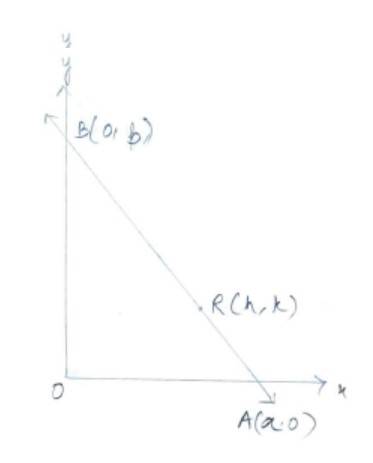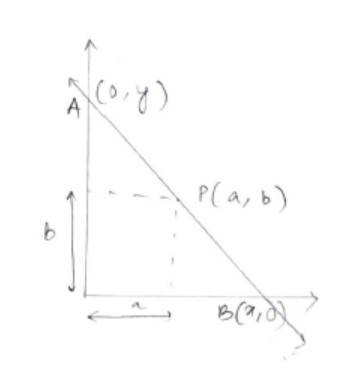Class 11th
Get insights from 8k questions on Class 11th, answered by students, alumni, and experts. You may also ask and answer any question you like about Class 11th
Follow Ask QuestionQuestions
Discussions
Active Users
Followers
New answer posted
6 months agoContributor-Level 10
7. Given,
A= {1, 2}, B = {1,2,3,4}, C= {5,6} and D= {5,6,7,8}
(i) L.H. S = A * (B∩ C) = {1,2} [ {1,2,3,4} ∩ {5,6}]
= {1,2}*
= .
R.H.S = (A* B)∩ (A *C)= [ {1,2}* {1,2,3,4}]∩ [ {1,2} {5,6}]
= [ { (1, 1), (1, 2), (1, 3), (1, 4), (2, 1), (2, 2), (2, 3), (2, 4)]∩ [ {1,5), (1,6), (2,5), (2,6)}]
= .
Hence, L.H.S= R.H.S.
(ii) A* C = {1, 2}* {5,6}
= { (1,5), (1,6), (2,5), (2,6)}
B* D = {1,2,3,4} * {5,6,7,8}
= { (1,5), (1,6), (1,7), (1,8), (2,5), (2,6), (2,7), (2,8), (3,5), (3,6), (3,7), (3,8), (4,5), (4,6), (4,7), (4,8)}
As every element of A C is also an element of B* D.
A *C B *D
New answer posted
6 months agoContributor-Level 10
35. Equation of line with intercept form is
As R (h, x) divides line segment joining point A (a, 0) and B (0, b) in the ratio 1 : 2 we can write,
So,
Hence, putting value of a and b in equation (1) we get,
New answer posted
6 months agoContributor-Level 10
6. Given,
A *B = { (a, x), (a, y), (b, x), (b, y)}
We know that,
A *B = { (p, q); p ∈ A and q ∈ B}
So, A = {a, b} and B = {x, y}.
New answer posted
6 months agoContributor-Level 10
34.
Since P (a, b) is the mid-point of the line segment say AB with points A (0, y) and B (x, 0) we can write,
So, the equation of line with x and y intercept 2a and 2b using intercept form is
Hence, proved
New answer posted
6 months agoContributor-Level 10
5. Given, A = {1,1}
So, A* A = { (1,1), (1,1), (1,1), (1,1)}
A *A *A = { (1,1), (1,1), (1,1), (1,1)} * {1,1}
= { (1,1.1), (1, 1), (1, ), (1,1,1), (1,1,1), (1,1), (1,1), (1,1,1)}
New answer posted
6 months agoContributor-Level 10
4. (i) False. Here P = {m, n}, n (p)=2
Q = {n, m}, n (Q)=2
n (P* Q) = n (P)* n (Q) = 2* 2 = 4.
So, P *Q = { (m, n), (m, m), (n, n), (n, m)}
(ii) True.
(iii) True. { A * (B ∩ ?) = A* ? . {∴ B ∩ ? = ? }
= n (A) *0 {? is empty set}
= ?
New answer posted
6 months agoContributor-Level 10
33. Assuming the price per litre say P in x-axis and the corresponding demand say D in y-axis, we have two point (14, 980) and (16, 1220) in xy plane. Then the points (P, D) will satisfy the equation.

Which is the required relation
Where P = 17, we have
D = 120 * 17 – 700
D = 1340
Hence, the owner can sell 1340 litres of milk weekly at? 17/litre
New answer posted
6 months agoContributor-Level 10
3. Given, G = {7, 8} and H = {5, 4, 2}
By the definition of the Cartesian product,
G *H = { (x, y): x∈G and y = ∈ H}
= { (7, 5), (7, 4), (7, 2), (8, 5), (8,4), (8,2)}
H* G = { (x, y): x∈ H and y ∈G}
= { (5, 7), (5, 8), (4,7), (4, 8), (2, 7), (2,8)}
New answer posted
6 months ago2. If the set A has 3 elements and the set B = {3, 4, 5}, then find the number of elements in (A*B).
Contributor-Level 10
2. Given, n (A) = 3
n (B) = 3 or B = {3,4,5}
So, number of elements in A* B = n (A* B) = n (A)* n (B) = 3 *3 = 9.
New answer posted
6 months agoContributor-Level 10
33. (i) False, as {2,3,4,5} ∩ {3,6} = {3} ≠ .Hence sets are not disjoint.
(ii) False as {a, e, i, o, u} ∩ {a, b, c, d} = {a} ≠ Hence sets are not disjoint.
(iii) True as {2,6,10,14} ∩ {3,7,11,15} = . Hence sets are disjoint.
(iv) True as {2,6,10} ∩ {3,7,11}= . Hence sets are disjoint.
Taking an Exam? Selecting a College?
Get authentic answers from experts, students and alumni that you won't find anywhere else
Sign Up on ShikshaOn Shiksha, get access to
- 65k Colleges
- 1.2k Exams
- 679k Reviews
- 1800k Answers


